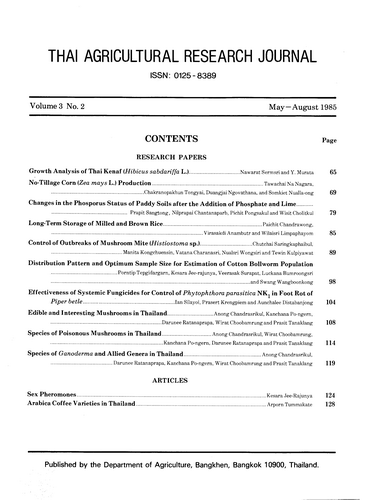Control of Outbreaks of Mushroom Mite (Histiostoma sp.)
Abstract
In a survey of mushroom growing areas in the Central Region of Thailand, the mushroom mite, Histiostoma sp., was identified as one of the most serious mushroom pests limiting production and often leading to production being abandoned. Histiostoma sp. were shown to cause damage in all stages of mushroom development including the mycelium growing stage, teh spawn growing stage and, spawn running stage.
The survey of mushroom production in the Central region showed that most production is in large production houses under generally dirty and unsanitary conditions. Pure culture spawns are often mixed with contaminated ones, providing conditions suitable for the outbreak of mite infestation and damage.
In a study of the problem, mass rearing of Histiostoma sp. and a study of their life cycle were undertaken under laboratory conditions. The life-cycle was shown to have two patterns. Under normal conditions the cycle was, egg-larva-protonymph-deutonymph-adult. Under adverse or poor environmental conditions, at the deutonymph stage the soft cuticle changed into a robuse body; this stage, called Hypopi, could abstain from feeding from 1 - 6 days and was assumed to play a major role in dispersal.
In a study of the control of Histiostoma sp., phosphine fumigant was found to be the most effective acaricide; it is non-toxic to the mycelium of the oyster umshroom, including studies of potential toxicity residue effects and their potential efficacy for controlling the Hypopi stage of development of the mite.
Downloads
Published
How to Cite
Issue
Section
License
Thai Agricultural Research Journal



